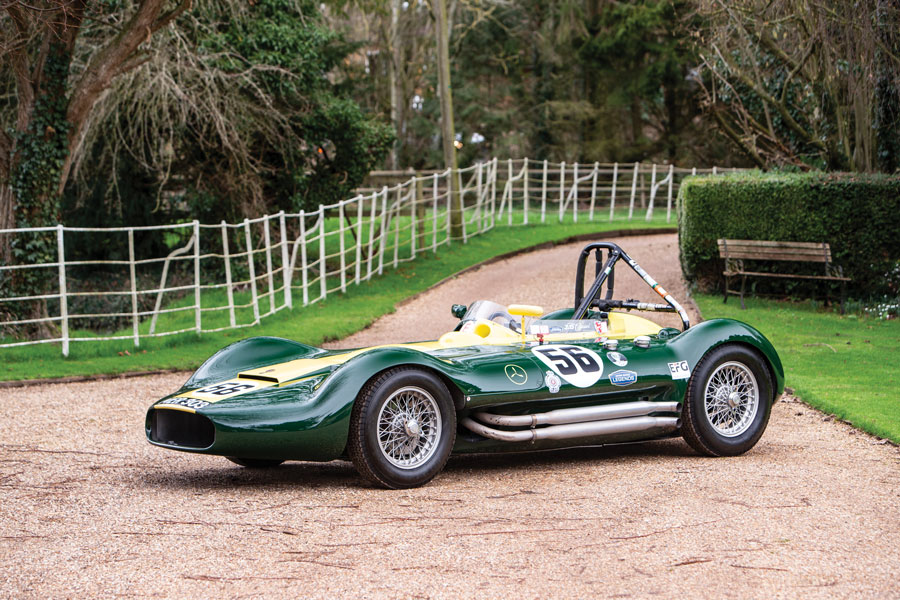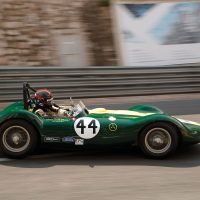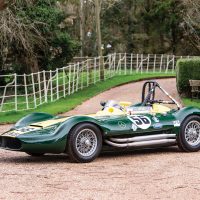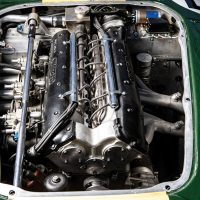SCM Analysis
Detailing
| Vehicle: | 1956 Lister-Maserati 2.0-Liter Sports Racer |
| Years Produced: | 1956 |
| Number Produced: | One |
| SCM Valuation: | $703,316 (this car) |
| Chassis Number Location: | Unknown |
| Engine Number Location: | Stamped on head |
| Alternatives: | 1956 Cooper Bobtail, 1956 Tojeiro Bristol, 1955 Maserati A6GCS |
| Investment Grade: | A |
This car, Lot 131, sold for $703,316, including buyer’s premium, at Bonhams’ Goodwood Members’ Meeting sale in Chichester, U.K., on March 29, 2020.
Every era has its heroes.
In mid-1950s English motor racing, few drivers caught the imagination of the public like Archie Scott Brown, for his sheer grit, determination and spectacular driving.
Brown was born to excellent circumstance in 1927, but his misfortune was that his mother had caught German measles while pregnant and Archie was born with horrible deformities. His right arm stopped just past the elbow with a vestigial thumb and palm sort of stuck to it. He had no shinbones in either leg, and his club feet were almost backward. Only his left arm and hand were normal.
His parents were game, and there was money available, so from age 2 through 6 or so, he got the best orthopedic care available. He ended up able to walk and operate more or less normally. He also developed an absolutely indomitable personality that served him through his chosen career, which was — amazingly — motor racing.
Brian Lister was also born to some means, as his family owned a successful engineering company. Out of school, he apprenticed with the family George Lister Company and quickly turned into an excellent hands-on engineer — able to design and build beautifully.
During the late 1940s, he fell in with the sporting-car crowd and tried his hand at racing but wasn’t very good. He ran across Archie racing and they became friends. Brian quickly relegated driving duties to Archie, choosing instead to build and maintain the cars for Archie to drive.
The Lister/Archie Scott Brown association was to define both Lister and Archie for the rest of their lives.
Making do after World War II
I need to step aside and talk for a bit about what English club racing was like in those days. In the years following the war, there was enthusiasm — but no money. People raced what they had. The circuits were mostly perimeter roads around abandoned airfields, which meant that they were mostly flat with successive open right-hand turns.
To suggest that suspensions, tires and brakes were crude would be an understatement, and nobody had any horsepower.
The way to win was simply to drop the hammer at the start and never lift, getting the car to drift (slide, wallow or slew) around every corner without losing any momentum. It made for very entertaining — if wildly dangerous — racing.
In those days, nobody could do this like Archie Scott Brown. With his good left hand clutching the steering wheel, his stump shifting gears, and his atrophied feet pushing the accelerator to the floor, he was incredible to watch and almost impossible to beat.
Lister steps in and dominates
By the summer of 1953, Brian Lister was toying with the idea of having the Lister Company build a racer for Archie to drive. It could be good exposure for the engineering firm and maybe even pay its way, he surmised. Although his father was circumspect, he allowed the project to proceed.
The big difference was that the new car wasn’t built in the back of someone’s garage. Lister & Co. were a proper company — with resources. So designs were checked and stresses calculated. All tubing was properly cut and fish-mouthed before being welded to a very high industrial standard.
Machine tools that an amateur could only dream of were standing ready. The resulting car, BHL1, was thus a very professional product, even if it was just the first try. Brian had chosen to run the car in the under 1,500-cc grid, so they used an MG engine, suitably modified.
The car debuted in April 1954 with Archie driving and proved nearly unbeatable. Competitors quickly noticed and beat a path to Lister to buy copies, and suddenly Lister was in the racing-car business.
With success begetting success, Brian and Archie started to consider a second chassis to run in the larger class. The problem with this class was that the only viable engine was the Bristol 2-liter. It was an old design, and very tall. The second chassis, the Lister Bristol, arrived in mid-season. Archie drove both, each in its own grid. He remained wild but impossible to beat.
A new, finicky car
The ultimate 2-liter race engine was reputedly the Maserati A6GC. Compact and powerful — but expensive — it was irresistible to Brian, so he bought one. The old Lister MG was dragged back from retirement and suitably modified to handle the new engine (some chassis tubes and mostly disc brakes). The new engine allowed an all-new body with almost a quarter less frontal area. It came together in the fall and winter of 1955 in anticipation of the 1956 season, and everybody involved thought it would be a jewel. As the new season opened, the flaw in the reasoning became apparent.
The Maserati engine was a piece of junk.
Though an inspired design, the build quality was horrible. Getting it to run at all was a challenge, getting it to run right and finish a race was almost impossible. When it ran right, it was a beautifully balanced car with great power and a fabulous Italian exhaust note: Everything was great except that it just couldn’t finish. Archie loved it dearly, though, and did manage a few high-profile wins and podium finishes. From Brian Lister’s standpoint, the frustration and expense weren’t worth it for the results, and by mid-summer it was relegated to storage as Archie followed other routes.
In the fall of 1956 Jaguar decided to abandon racing, which opened up a supply of D-type race engines and a substantial amount of sponsorship funding, so Lister decided to build an evolution chassis to handle the weight and horsepower now available, and Lister became famous for the Lister Jaguars. The Maserati was a forgotten relic as the Lister Jaguars and Archie went international.
Archie finally ran out of luck in May of 1958 at Spa, in the wet, when his Lister got wide and tripped at a very fast part of the course. Brian was devastated. It was over.
An amazing relic
So, what are we to make of the Lister Maserati? It is certainly a glorious piece of English racing history. Both the first and third factory racing chassis raced, and it is endowed with a glorious jewel of a Maserati engine.
The engine’s unreliability has long since been replaced with modern understanding and build quality for a powerful and dependable present. It is unquestionably attractive — and by all accounts wonderful to drive. Fitting in it may be an issue, as Archie was tiny and it was built specifically around him.
I will suggest that our subject race car was bought as a collection cornerstone more than any kind of active racer. Save Goodwood, there are few venues appropriate to a car like this.
The car is definitely iconic. The provenance, alloy body and Maserati engine definitely add value, but we seem to be in a soft market for weird, iconic racers these days.
A few years ago, I’d have thought of this as a million-dollar car. In today’s market, I suggest it was fairly bought. ♦



